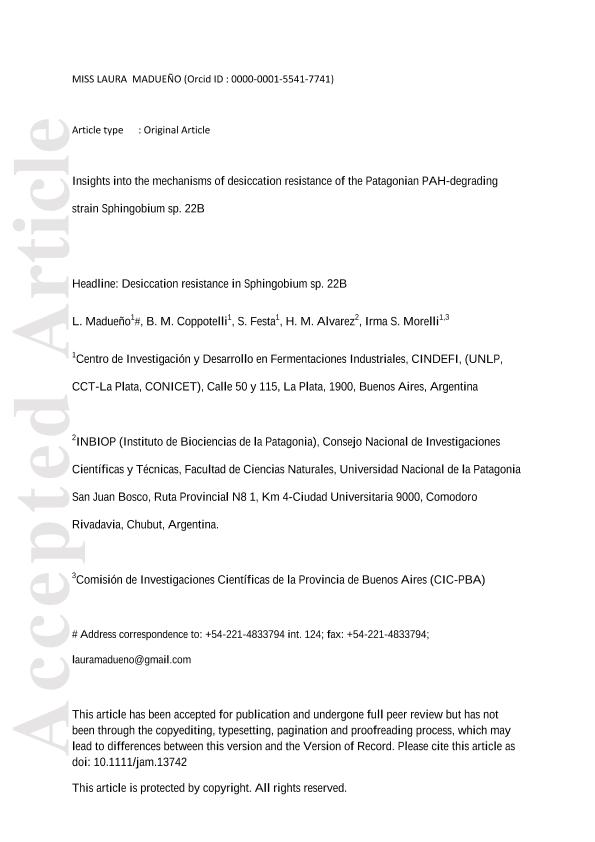Mostrar el registro sencillo del ítem
dc.contributor.author
Madueño, Laura

dc.contributor.author
Coppotelli, Bibiana Marina

dc.contributor.author
Festa, Sabrina

dc.contributor.author
Alvarez, H. M.
dc.contributor.author
Morelli, Irma Susana

dc.date.available
2019-11-27T18:21:29Z
dc.date.issued
2018-02
dc.identifier.citation
Madueño, Laura; Coppotelli, Bibiana Marina; Festa, Sabrina; Alvarez, H. M.; Morelli, Irma Susana; Insights into the mechanisms of desiccation resistance of the Patagonian PAH-degrading strain Sphingobium sp. 22B; Wiley Blackwell Publishing, Inc; Journal of Applied Microbiology; 2-2018; 1532-1543
dc.identifier.issn
1364-5072
dc.identifier.uri
http://hdl.handle.net/11336/90677
dc.description.abstract
AimTo analyze the physiological response of Sphingobium sp. 22B to water stress.Methods and resultsThe strain was grown under excess of carbon source and then submitted to low (60RH) and high (18RH) water stress conditions for 96 h. Quantification of trehalose, glycogen, polyhydroxybutyrate (PHB), and transmission electron microscopy (TEM) was studied. Genes linked with desiccation were searched in Sphingobium sp. 22B and Sphingomonas ?sensu latu? genomes and their transcripts were quantified by Real-Time PCR. Results showed that, in absence of water stress, strain 22B accumulated 4.76± 1.41% of glycogen, 0.84± 1.62% of trehalose and 44.9± 6.4% of PHB per cellular dry weight. Glycogen and trehalose were mobilized in water stresses conditions, this mobilization was significantly higher in 60RH in comparison to 18RH. Gene treY was upregulated 6-fold change in 60RH relative to 18RH. TEM and quantification of PHB revealed that PHB was mobilized under 60RH condition accompanied by the downregulation of the phbB gene. TEM images showed an extracellular amorphous matrix in 18RH and 60RH. Major differences were found in the presence of aqpZ and trehalose genes between strain 22B and Sphingomonas genomes.ConclusionStrain 22B showed a carbon conservative metabolism capable of accumulation of three types of endogenous carbon sources. The strain responds to water stress by changing the expression pattern of genes related with desiccation, formation of an extracellular amorphous matrix and mobilization of the carbon sources according to the degree of water stress. Trehalose, glycogen and PHB may have multiple functions in different degrees of desiccation. The robust endowment of molecular responses to desiccation shown in Sphingobium sp. 22B could explain its survival in semiarid soil.Significance and Impact of the studyUnderstanding the physiology implicated in the toleration of the PAH-degrading strain Sphingobium sp 22B to environmental desiccation may improve the bioaugmentation technologies in semiarid hydrocarbons contaminated soils.
dc.format
application/pdf
dc.language.iso
eng
dc.publisher
Wiley Blackwell Publishing, Inc

dc.rights
info:eu-repo/semantics/openAccess
dc.rights.uri
https://creativecommons.org/licenses/by-nc-sa/2.5/ar/
dc.subject
PAH-degrading Sphingomonas
dc.subject
Sphingobium sp. 22B
dc.subject
Desiccation
dc.subject
Water stress
dc.subject.classification
Otras Biotecnología del Medio Ambiente

dc.subject.classification
Biotecnología del Medio Ambiente

dc.subject.classification
INGENIERÍAS Y TECNOLOGÍAS

dc.title
Insights into the mechanisms of desiccation resistance of the Patagonian PAH-degrading strain Sphingobium sp. 22B
dc.type
info:eu-repo/semantics/article
dc.type
info:ar-repo/semantics/artículo
dc.type
info:eu-repo/semantics/publishedVersion
dc.date.updated
2019-10-15T13:13:01Z
dc.journal.pagination
1532-1543
dc.journal.pais
Reino Unido

dc.description.fil
Fil: Madueño, Laura. Consejo Nacional de Investigaciones Científicas y Técnicas. Centro Científico Tecnológico Conicet - La Plata. Centro de Investigación y Desarrollo en Fermentaciones Industriales. Universidad Nacional de La Plata. Facultad de Ciencias Exactas. Centro de Investigación y Desarrollo en Fermentaciones Industriales; Argentina
dc.description.fil
Fil: Coppotelli, Bibiana Marina. Consejo Nacional de Investigaciones Científicas y Técnicas. Centro Científico Tecnológico Conicet - La Plata. Centro de Investigación y Desarrollo en Fermentaciones Industriales. Universidad Nacional de La Plata. Facultad de Ciencias Exactas. Centro de Investigación y Desarrollo en Fermentaciones Industriales; Argentina
dc.description.fil
Fil: Festa, Sabrina. Consejo Nacional de Investigaciones Científicas y Técnicas. Centro Científico Tecnológico Conicet - La Plata. Centro de Investigación y Desarrollo en Fermentaciones Industriales. Universidad Nacional de La Plata. Facultad de Ciencias Exactas. Centro de Investigación y Desarrollo en Fermentaciones Industriales; Argentina
dc.description.fil
Fil: Alvarez, H. M.. Universidad Nacional de la Patagonia "San Juan Bosco". Instituto de Biociencias de la Patagonia. Consejo Nacional de Investigaciones Científicas y Técnicas. Centro Científico Tecnológico Conicet - Centro Nacional Patagónico. Instituto de Biociencias de la Patagonia; Argentina
dc.description.fil
Fil: Morelli, Irma Susana. Consejo Nacional de Investigaciones Científicas y Técnicas. Centro Científico Tecnológico Conicet - La Plata. Centro de Investigación y Desarrollo en Fermentaciones Industriales. Universidad Nacional de La Plata. Facultad de Ciencias Exactas. Centro de Investigación y Desarrollo en Fermentaciones Industriales; Argentina
dc.journal.title
Journal of Applied Microbiology

dc.relation.alternativeid
info:eu-repo/semantics/altIdentifier/url/http://doi.wiley.com/10.1111/jam.13742
Archivos asociados
